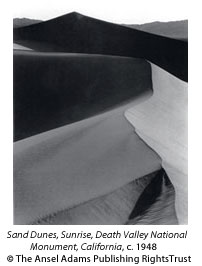|
ANSEL ADAMS: Classic Images
Sand Dunes, Sunrise, Death Valley National Monument,
California, c. 1948
To learn more about this photograph see the information below. To see a larger view of this image as a PDF file format, click on the image... This image is copyrighted by The Ansel Adams Publishing Rights Trust and cannot be printed or reproduced in any way. The use of the photograph is limited to viewing in the context of this web site.
|
|
|
Sand Dunes, Sunrise, Death Valley National
Monument, California, c. 1948 A. What did Adams see when he arrived to take the shot? B. How and why did Adams photograph Sand Dunes at sunrise? C. Why do you think photographers find deserts a difficult subject? D. What does it mean to "visualize" the photograph in the mind's eye? E. Why is Sand Dunes a photograph sometimes termed abstract? F. Technical Aspects G. Related links in this site A. What did Adams see when he arrived to take the shot? B. How and why did Adams photograph Sand Dunes at sunrise? C. Why do you think photographers find deserts a difficult subject? D. What does it mean to "visualize" the photograph in
the mind's eye? Does the human eye or the camera capture a truer picture? According
to Adams, the eye actually "perceives great luminosity and texture"
in shadows in deserts. Through the limitations of the camera apparatus,
shadows appear almost solid black which is "visually untrue. E. Why is Sand Dunes a photograph sometimes termed abstract? F. Technical Aspects
G. Related links in this site
|
|
|
ANSEL ADAMS: Classic Images
Sand Dunes, Sunrise, Death Valley National Monument,
California, c. 1948
To learn more about this photograph see the information below. To see a larger view of this image as a PDF file format, click on the image... This image is copyrighted by The Ansel Adams Publishing Rights Trust and cannot be printed or reproduced in any way. The use of the photograph is limited to viewing in the context of this web site.
|
|
|
Sand Dunes, Sunrise, Death Valley National
Monument, California, c. 1948 A. What did Adams see when he arrived to take the shot? B. How and why did Adams photograph Sand Dunes at sunrise? C. Why do you think photographers find deserts a difficult subject? D. What does it mean to "visualize" the photograph in the mind's eye? E. Why is Sand Dunes a photograph sometimes termed abstract? F. Technical Aspects G. Related links in this site A. What did Adams see when he arrived to take the shot? B. How and why did Adams photograph Sand Dunes at sunrise? C. Why do you think photographers find deserts a difficult subject? D. What does it mean to "visualize" the photograph in
the mind's eye? Does the human eye or the camera capture a truer picture? According
to Adams, the eye actually "perceives great luminosity and texture"
in shadows in deserts. Through the limitations of the camera apparatus,
shadows appear almost solid black which is "visually untrue. E. Why is Sand Dunes a photograph sometimes termed abstract? F. Technical Aspects
G. Related links in this site
|
|
